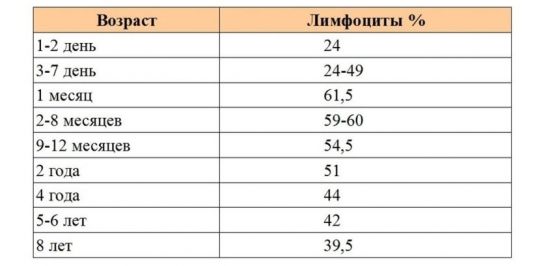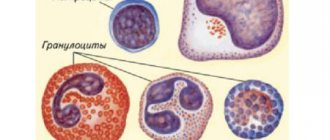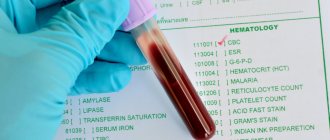General blood tests
03/20/201801/24/2019 Yulia Martynovich (Peshkova) 2074 Views children, lymphocytes, general tests
From birth, the baby is prescribed a set of mandatory tests, including a general blood test. One of the most important criteria that is determined during this analysis is the level of lymphocytes. The study allows you to identify an infectious infection of a child, as well as assess the severity of an allergic reaction and the negative effects of certain medications.
It is extremely important to correctly interpret the results of the analysis, taking into account the age of the child and the clinical picture of the disease. The norm of lymphocytes differs in children of different ages, with a difference of up to several months.
- 1 What are lymphocytes?
- 2 What is the purpose of the research?
- 3 Norm of lymphocytes in a child’s blood
- 4 Lymphocytosis in children
- 5 Lymphopenia in a child
- 6 Methodology of analysis
- 7 Preparing a child for analysis
- 8 Treatment of lymphocytosis and lymphopenia
- 9 What's the result?
What are lymphocytes?
Lymphocytes are a type of leukocyte. Depending on the morphological structure, it is customary to distinguish large (natural killer) and small cells (T- and B-lymphocytes).
It’s not for nothing that they say that lymphocytes are the guardians at the gates of health. This statement is based on the role of lymphocytes in the human body - protection against pathogens. In addition, they are able to recognize and destroy mutant cancer cells in the human body.
A distinctive feature of lymphocytes is the ability to provide a person with 2 types of immunity: humoral and cellular. The first is realized through the synthesis of protein molecules (antibodies), which are characterized by high affinity for various pathogenic microorganisms. After direct interaction of antibodies with antigens of the pathogen, a stable complex is formed. As a result of such interaction, toxins (poisonous substances synthesized by pathogenic microorganisms) are neutralized or the process of reproduction of a foreign cell is stopped.
The second (cellular) immunity is based on the direct participation of lymphocytes in the process of destroying pathogens, as well as on the regulation of the work of all other types of leukocytes.
The answer to the question of what is the normal level of immune cells in the blood is presented in the table (the values are given for patients over 16 years of age).
| Leukocyte type | Normal content |
| Neutrophils | 45 – 70 % |
| Lymphocytes | 20 – 35 % |
| Monocytes | 3 – 10 % |
| Eosinophils | 1 – 5 % |
| Basophils | 0 – 2 % |
The role of lymphocytes in the body
Lymphocytes are one of the types of white blood cells - leukocytes, which ensure adequate functioning of the immune system. Like other leukocytes, they are formed in the bone marrow. Compared to other white blood cells - neutrophils, eosinophils, basophils and monocytes - lymphocytes play the role of a kind of “commanders”. Their number of the total number of leukocytes is about 30%, and they bear the main responsibility for the immune response.
Lymphocytes belong to agranulocytes, that is, cells that do not have granular inclusions in their structure. Unlike other leukocytes, they do not die when confronted with an infectious agent, but can perform their function repeatedly over several years and are then destroyed in the spleen. Thus, lymphocytes provide long-term immunity, while other leukocytes provide short-term immunity.
The activities of these cells are diverse and are entirely based on their specialization. They are responsible for humoral immunity, which supports the production of antibodies, and cellular immunity, which ensures interaction with target cells. According to their characteristics and specialization, lymphocytes are divided into 3 main groups - T, B and NK.
T cells
This type makes up about 75% of all lymphocytes. They originate in the bone marrow and later move to the thymus (thymus gland), where they become lymphocytes. Their name T stands for the place of formation, that is, the thymus. In children, there are significantly more such cells compared to adults.
In the thymus, lymphocytes develop depending on the intended specification and transform into the following subtypes:
- T-cell receptors - their activity is aimed at detecting protein antigens.
- Helper T cells are “commander” cells that coordinate protective capabilities by activating other types of immune cells.
- T-killers - perform a neutralizing function by destroying bacteria or viruses, as well as some cancer cells.
- T-suppressors are lymphocytes responsible for inhibiting the immune response. As a rule, there are a small number of such cells.
Close-up photo of T lymphocytes
B cells
Among other lymphocytes, their share usually does not exceed 15%. B cells are formed in the spleen and bone marrow, after which they are transported to the lymph nodes, accumulating there. Their main activity is aimed at providing humoral immunity. While in the lymph nodes, B lymphocytes recognize and evaluate antigens from other immune cellular units. Then, if necessary, the processes of forming antibodies are launched to respond to attacks by foreign microorganisms or substances.
Fact! Some B lymphocytes retain “memory” in relation to foreign objects for many years. Through this ability, they ensure the body’s readiness to resist pathogenic penetration in the event of its repeated entry.
NK cells
These cells are even smaller in relation to other lymphocytes, and they make up approximately 10%. Their purpose is almost identical to the functions of T-killers. At the same time, the possibilities are much higher. They are aimed at destroying degenerated cells, for example, cancerous ones or those affected by viruses. In addition, they can eliminate cells that are inaccessible to T lymphocytes, since each unit of the NK subtype has special toxins that cause death to target cells.
What is the purpose of the research?
A referral for testing can be written by a doctor - pediatrician, surgeon, infectious disease specialist or hematologist. The norm of lymphocytes in the blood of children is determined for the purpose of:
- diagnosing the presence of infectious diseases;
- differential diagnosis of viral and bacterial infections;
- determining the degree of immunity, which reflects the body’s ability to resist infectious agents;
- diagnosing the presence of helminth infestation;
- establishing the severity of an allergic reaction;
- early detection of side effects from taking medications;
- detection of immunodeficiency conditions;
- primary differential diagnosis of leukemia (bleeding) and determining the effectiveness of the chosen treatment tactics.
Norms for children
To determine the number of lymphocytes in the blood of children, they, like adults, undergo a complete blood count (CBC). It is quite simple to understand whether the indicators of the leukocyte formula, and in particular lymphocytes, correspond: the study forms almost always indicate the upper and lower limits of all indicators.
Most often, the results of such tests look like a table, and lymphocytes are designated by the letters LYM. The rate of lymphocytes in a child’s blood varies throughout his or her growing up. From birth to one month, the content of these cells can change several times. Thus, in infants (up to 1 year), the values of lymphocytes are in the range of 45-65% (if there are slight deviations, then they are usually considered normal).
A high rate does not affect immunity, since at this age the described blood cells are too weak. As the child grows up, the body's protective function steadily increases. In children aged 1 to 7 years, the rates decrease slightly and range from 25 to 55%.
Stabilization of the immune system, and specifically lymphocytes, occurs at the age of 7-8 years, and their number stops at 25-50%. If the tests show minor changes in one direction or another, then there is no need to worry: each child’s body is individual, and the development process can proceed differently.
Important! If there is a significant decrease or increase in lymphocytes in children, you should immediately consult a doctor to determine the causes of pathological failures.

Indicators of normal lymphocytes for children of different ages
The norm of lymphocytes in the blood of a child
Important: it is prohibited to independently establish a diagnosis and choose treatment methods.
Such tactics can lead to a delay in the appointment of effective therapies and, as a result, a deterioration in health. When making a final diagnosis, the doctor takes into account various methods of laboratory and instrumental examination of the patient.
The norm of lymphocytes (reference values) in children is collected in the table by age.
| Age | Norm, *109 / l |
| Up to 12 months | 2 – 11,5 |
| From 1 to 2 years | 2,5 – 9,8 |
| From 2 to 4 years | 2 – 8,5 |
| From 3 to 4 years | 2 — 8 |
| From 4 to 6 years | 1,3 – 7,5 |
| From 6 to 8 years | 1,5 — 7 |
| From 8 to 10 years | 1,5 – 6,8 |
| From 10 to 15 years | 1,3 – 5,5 |
| Over 15 years old | 1 – 5 |
It is important to remember that the physiological norm is individual for each person. A slight excess of standard values has no diagnostic value and can be caused by a number of reasons (improper preparation, violation of analysis technology, or errors at the preanalytical stage). In this case, a repeat study is indicated after 3-5 days.
Lymphocytosis in children
Main article: Elevated lymphocytes in a child
Lymphocytosis is a pathological condition in which a significant deviation from the reference values is recorded. It should be noted that the norm of lymphocytes in children under one year of age is characterized by maximum permissible values and is not considered a pathology. Depending on the degree of deviation from the reference values, absolute and relative lymphocytosis are distinguished.
The value of lymphocytes significantly exceeding the norm is considered absolute. The number of lymphocytes exceeding 60-80% in a child (especially up to one year old) is a sufficient reason to order an urgent comprehensive examination in order to establish the causes, including:
- acute stage of viral infection (infectious mononucleosis, cytomegalovirus infection, influenza, hepatitis);
- bacterial diseases (whooping cough, tuberculosis, brucellosis);
- damage to the lymphatic system, accompanied by the accumulation of lymphocytes.
So, if in a blood test in children up to 55% of lymphocytes are recorded, then we are talking about relative lymphocytosis, the causes of which may be:
- rheumatic diseases;
- hyperfunction of the thyroid gland and, as a consequence, an excess amount of hormones synthesized by it;
- chronic insufficiency of the adrenal cortex;
- abnormal increase in the size of the spleen.
Lymphocyte count in adults:
The norm of lymphocytes in children and adults is different. The main difference is that in the latter the lymphocyte count does not fluctuate, but remains stable, unlike infants and young children. In any teenager and adult, the number of these cells in a general blood test is 20-40%. This corresponds to 1-3 thousand cells in 1 microliter of blood (if we evaluate the indicator not as a percentage, but as an absolute number). However, accurate quantitative counts are rarely carried out, so the generally known norm of lymphocytes is the 20-40% indicated above. Deviations within 4-5% up or down are not considered pathology.
Analysis methodology
Parents are often interested in the question of how lymphocytes are determined in children? The count of lymphocytes is carried out in an extended clinical blood test using the SLS (sodium lauryl sulfate) method. In most cases, the results obtained indicate the percentage of all blood cells and the total number of leukocytes, without specifying the ratio of each type of cell.
If a deviation from the norm is detected, the doctor prescribes an analysis - leukocyte formula (flow cytometry method), which involves microscopy of a blood smear with a count of all types of white blood cells.
The period for obtaining results varies depending on the workload of the laboratory and can range from 2 hours to 1 day, not counting the day of taking the biomaterial.
Preparing a child for analysis
The biomaterial used for research is venous or capillary blood serum. The accuracy and reliability of the results obtained by the patient depends on the correct preparation of the patient for the procedure of taking biomaterial. Basic rules for preanalytical preparation of a baby:
- It is recommended to donate blood on an empty stomach; children under 3 years of age are allowed to go 2-3 hours without food;
- the importance of giving your child plenty of unsweetened, still water. This will greatly facilitate the collection of biomaterial and reduce the risk of hemolysis in vitro;
- Poor tolerance of blood donation has a negative impact on results. Emotional stress changes the functioning of the enzymatic system and distorts the data obtained, so you need to try to calm the child as much as possible.
If the use of medications is indicated for the child, the laboratory employee should be informed of their name. It is known that some medications have a lowering effect on the level of lymphocytes in the blood.
Lymphopenia in children
The pathology in which low lymphocytes are noted is called lymphopenia, and it has 2 forms - absolute and relative. In the first case, the reason for the low level of these blood cells is bone marrow dysfunction, which is why few of them are produced. This is a characteristic symptom for such serious diseases as lymphocytic leukemia, liver disease, immunodeficiency, etc. With a significant decrease in indicators in newborns, there is a risk of death.
A relative form of lymphopenia develops against the background of excessive production of neutrophils. Most often this is associated with acute infectious diseases. In addition, a condition where lymphocytes in a child’s blood are low is often caused by hereditary factors. All other cases are acquired.
Causes
Most often, lymphocytes are reduced for the following reasons:
- condition after chemotherapy or a course of immunosuppressants;
- systemic diseases – lupus erythematosus, rheumatism, etc.;
- tuberculosis, typhoid, measles, hepatitis and other infections;
- prolonged stress and unbalanced nutrition;
- physical injuries, burns to the skin;
- intestinal obstruction, appendicitis;
- kidney and thymus diseases;
- chronic intoxication;
- rehabilitation period.
Symptoms
Signs of pathology, as a rule, are not clearly expressed, and are often very similar to the manifestations of enlarged lymphocytes. The most common are weakness, apathy, pallor and yellowness of the skin, frequent colds, damage to the oral mucosa, inflammation of the skin and shrinkage of the tonsils. But in most cases, only two symptoms indicate the presence of pathology - headache and weakness.
If the CBC showed low lymphocytes, then the doctor needs to find the cause of this condition. It is very important for the child to describe his feelings. At the same time, additional examinations will be prescribed - a general urine test, blood biochemistry and an immunogram. Then you will need consultations with specialized specialists - an oncologist, an immunologist or a hematologist.
Reference! For preventive purposes, chronic lymphopenia is often prescribed a course of immunoglobulins. For congenital pathology, the most effective type of therapy is bone marrow transplantation.

Weakness and headache are the two most common signs of lymphopenia
In case of chronic intoxication, which develops in children living with smoking relatives, the child’s contact with tobacco smoke should be minimized as much as possible. It is optimal if they completely stop smoking in the house or do it only outside.
Treatment of lymphocytosis and lymphopenia
This issue should only be dealt with by a specialist. Initially, it is necessary to establish the cause that caused the pathological condition. In case of a viral infection, antiviral drugs are prescribed; in case of a disease of bacterial etiology, antibiotics or bacteriophages are prescribed.
When selecting drug therapy, you should focus on the minimum acceptable age, which is prescribed in the instructions for each drug. When selecting aggressive treatment methods, the comparative damage to the child’s body from the disease and from the medicine is assessed.
It is unacceptable to independently select the drug and its dosage, as well as use alternative medicine methods without first consulting a doctor.






